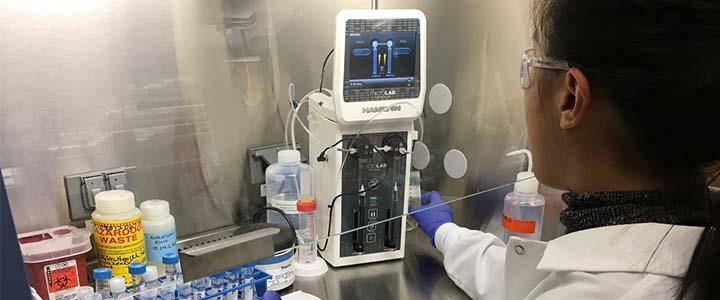
Interdepartmental Collaboration Creates First-of-its-Kind Human and Environmental Dataset
Over the past two years, staff from the New Hampshire Departments of Health and Human Services (NH DHHS) and Environmental Services (NHDES) have worked tirelessly on the state’s first biomonitoring surveillance study. Biomonitoring is the evaluation of human exposure to environmental chemicals by testing for chemicals or chemical breakdown products in clinical specimens (blood, urine, etc.). The Centers for Disease Control and Prevention (CDC) conducts a national biomonitoring surveillance study every two years and compiles the data into a report; however, state-level information is not available. With the help of many partners, the BiomonitoringNH Program, which is part of the NH DHHS Public Health Laboratories Chemistry Program, ambitiously took on the same task.
With New Hampshire grit in their souls and a dedicated (possibly stubborn) mindset, the BiomonitoringNH toxicologists and epidemiologists dreamed of creating a large dataset of not only clinical results but also drinking water quality in order to identify populations most at risk for chemical exposures. With almost half of New Hampshire’s population using unregulated private drinking water wells, contaminated water is a risk to many residents. BiomonitoringNH sought assistance from the NHDES Drinking Water and Groundwater Bureau, the New Hampshire Drinking Water and Groundwater Trust Fund, and the NH DHHS Environmental Public Health Tracking (EPHT) Section in order to collect and fund testing for hundreds of water samples. With support from these partners, the 2019 New Hampshire Tracking and Assessment of Chemical Exposures (TrACE) Study was launched.
From June to September 2019, 336 residents from 180 private well and 94 public water system (PWS) households were recruited for clinical and water testing. Fifty biomonitoring chemicals were tested in whole blood, serum and urine: metals and metalloids; per- and polyfluoroalkyl substances (PFAS); pesticide metabolites; and cotinine (a nicotine metabolite indicating exposure to tobacco). Both raw (untreated) and finished (post-treatment, if present) water samples were tested in private well households and finished water was tested in PWS households.
A team from BiomonitoringNH, NHDES, and EPHT assembled regularly to discuss how to analyze the results and how to present the data for public and environmental health stakeholders. Some of the most interesting results from the 2019 TrACE Study include:
- Multiple PWSs across the state were not yet in compliance with the new arsenic standard of 5 ug/L.
- TrACE participants had higher levels of cadmium, cesium, lead, PFDA (a type of PFAS), PNP (an insecticide metabolite), total arsenic, and total mercury in their bodies when compared to the US population.
- TrACE private well water users had higher levels of lead, PFOS (a type of PFAS), and uranium in their bodies than TrACE public drinking water users.
- There was a trend of increasing levels of inorganic arsenic, lead, PFOA, and uranium in TrACE participants as the amount of those chemicals increased in home water.
- Drinking water from households served by a PWS had fewer exceedances of health limits or screening levels than water from private wells, showing the need for the regular testing and treatment of private wells.
These results and more were published in a summary report. Paper copies can be requested by emailing BiomonitoringNH@dhhs.nh.gov. For more information, contact Amanda Cosser at amanda.cosser@dhhs.nh.gov or (603) 271-4611.
BiomonitoringNH is extremely grateful to have worked with their NHDES and NH DHHS partners on this project and we look forward to supporting future collaborations in order to achieve our joint goals of excellent public and environmental health in New Hampshire.




